| Article ID | Journal | Published Year | Pages | File Type |
|---|---|---|---|---|
| 6724674 | Construction and Building Materials | 2013 | 6 Pages |
Abstract
Pozzolanic concrete has been widely used in various projects. In this study, fly ash and slag concretes were placed in the solution of 5% sodium sulfate under drying-wetting and temperature change cycles and long-term immersion, to simulate the effect of structures in tidal zones and seawater, respectively. The durability of concrete is assessing by using modified Accelerated Chloride Migration Test (ACMT). The results indicate that adding 20% fly ash and 40% slag concrete curing at 23 °C and 100% R.H. for 4 months, the chloride ion non-steady state migration coefficient (Mn) were 69% and 28% that of ordinary concrete, respectively. Ordinary and fly ash concrete were placed in the solution of 5% sodium sulfate under drying-wetting and temperature change cycles for 12 weeks, Mn were reduced to 82% and 33% of the initial value, respectively. This result represented that after the cycle procedure the ability of resisting chloride ion penetration increased. However, Mn of slag concrete became 2 times of the initial value, it represented that slag concrete was deteriorated under drying-wetting and temperature change cycles. In addition, results showed that Mn was approximately 3-10 times against steady state migration coefficient (Ms), and it is higher than the predicted value of the NIST program. This result indicating the modified ACMT will underestimate the durability of concrete, but it still can be a method for comparing durability of different kinds of concrete.
Keywords
Related Topics
Physical Sciences and Engineering
Engineering
Civil and Structural Engineering
Authors
Wen-Ten Kuo, Chih-Chien Liu, Jui-Yang Wang,
